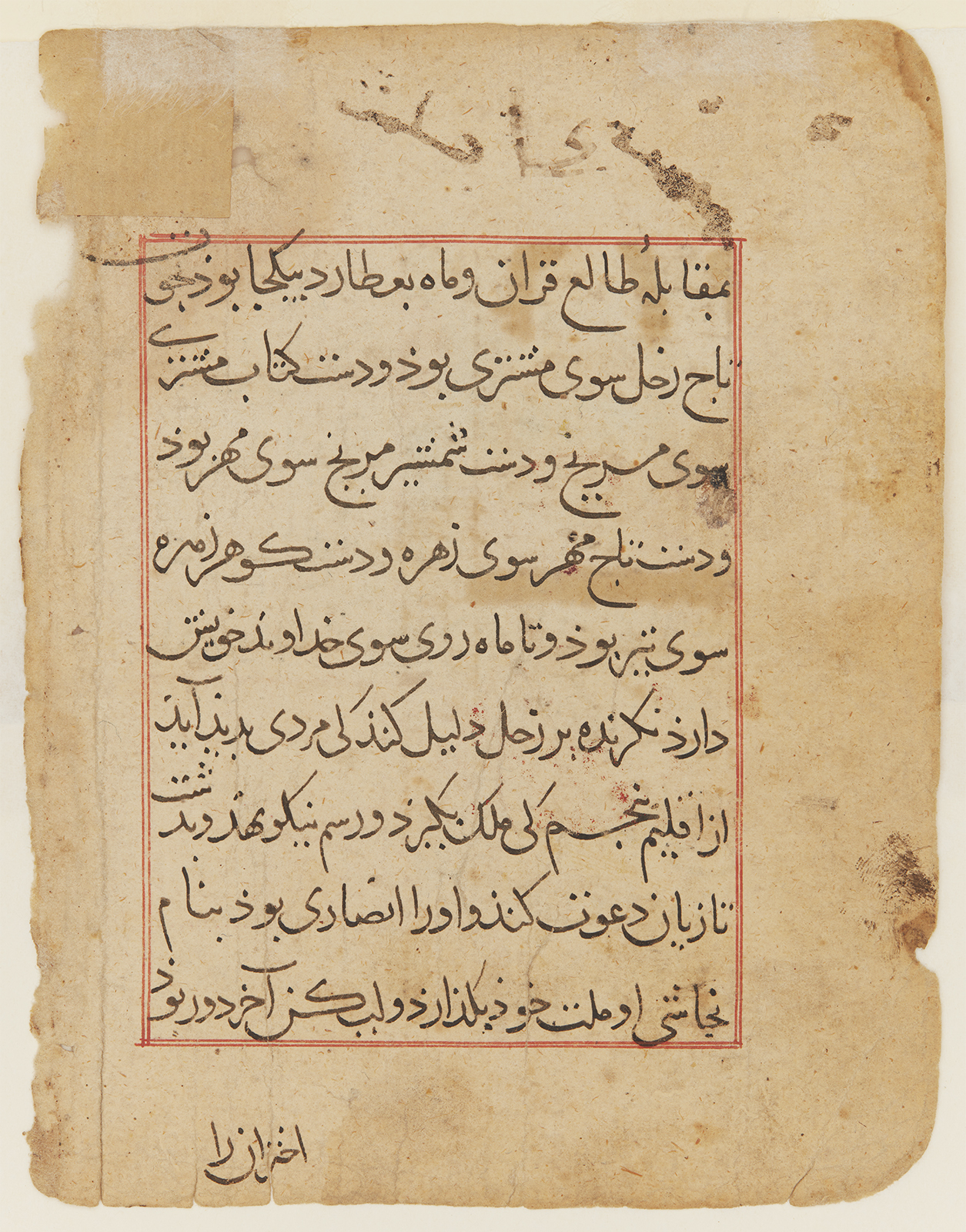Click on the image to zoom
Horoscope of King Kay Kavus
- Accession Number:AKM87
- Place:Iran, Shiraz
- Dimensions:15.5 x 12.1 cm
- Date:early 14th Century
- Materials and Technique:Ink, watercolour, and gold pigment on paper
This folio, along with two others in the Aga Khan Museum Collection (AKM26 and AKM86), comes from the earliest and only illustrated manuscript of an untitled and anonymous Zoroastrian apocalyptic text written after the Mongol conquest of the Middle East.[1] Like AKM86, which it follows in the original manuscript, this folio includes, in the upper left quadrant, a seated figure surrounded by standing attendants, and, in the lower right quadrant, a box comprising nine squares whose corner squares are bisected radially. This is a common format for horoscopes in Islamic astronomical and astrological works at least since the 8th century. Typically, the central square gives the name of the subject (in this case, Kay Kavus), and the surrounding 12 fields correspond to the 12 zones or houses of the sky that influence different aspects of human life. The zodiac signs are mapped onto these twelve houses, and are indicated by an Arabic letter cipher known as abjad, with aleph indicating Taurus, ba standing in for Gemini, and so forth. The names of the planets are also written in the outer fields. The relationships among the planets, the signs of the zodiac, and the 12 houses of the sky can thus be read and their significance interpreted for what it tells about the person whose appearance they accompany.
Further Reading
Interestingly, the horoscope figures on both AKM86 and AKM87 contain several errors. The text on folio AKM86 describing the horoscope of Ardavan begins with a mention of a planetary conjunction in Cancer (which, since antiquity, had been considered particularly ominous),[2] but the figure of Ardavan’s horoscope has been conflated with that of Ardashir, which originally appeared immediately before it. Likewise, the horoscope on AKM87 is wrongly drawn: two of the four radial lines in the corners of the figure have been added incorrectly, and the planet Mars has been placed in Scorpio and only later added to Libra to correspond with the text. Such errors are unusual among the surviving pages of the manuscript; in other examples, the horoscope figures closely match their description in the text. It should be remembered, however, that these horoscopes do not correspond to actual celestial observation. Instead, they have been invented in order to create the sense of an astrological pattern behind the character and actions of the individuals described in the text. This approach is well in line with the purpose of apocalyptic texts, which are less concerned with the actual events of the past than with finding patterns within those events that help to explain recent cultural trauma, such as the Mongol invasions represented for the Zoroastrian community of Iran.
— Stefan Kamola
Notes
[1] The full text can be found in Paris BnF ms. Sup. persan 380 and, slightly abbreviated, in London BL ms. Add. 7714. The text of this folio can be found in the Paris manuscript, folios 29b-30a. Additional folios from this manuscript are found in the Princeton University Library (mss. Garrett 91G and 92G), Harvard University Library (ms. Persian 26), the al-Sabah Collection (LNS MS. 50a-b), and the Royal Ontario Museum (980.115.7a-c). High resolution images of the Princeton folios from this collection (Princeton University Library ms. Garrett 91G and 92G), are available online: http://pudl.princeton.edu/objects/7d278w76c. High resolution images of the Harvard folio (ms. Persian 26) are available online: https://iiif.lib.harvard.edu/manifests/view/drs:10773911$1i.
[2] See Seneca, Quaestiones Naturales 3.29.1.
References
Adamova, A., and M. Bayani, Persian Painting: the Arts of the Book and Portraiture, London, 2015. ISBN: 9780500970676
Grube, E., Muslim Miniature Paintings from the XIII to XIX Century from Collections in the United States and Canada, Venice, 1962.
Kamola, S., “Lords of the Age: a Thirteenth-Century Zoroastrian Apocalypse from Fars” (forthcoming).
Nykl, A.R., “Ali ibn Abi Talib’s Horoscope,” Ars Islamica 10 (1943), 152–3.Welch, A., Collection of Islamic Art. Volume III, Geneva, 1978.
Note: This online resource is reviewed and updated on an ongoing basis. We are committed to improving this information and will revise and update knowledge about this object as it becomes available.




